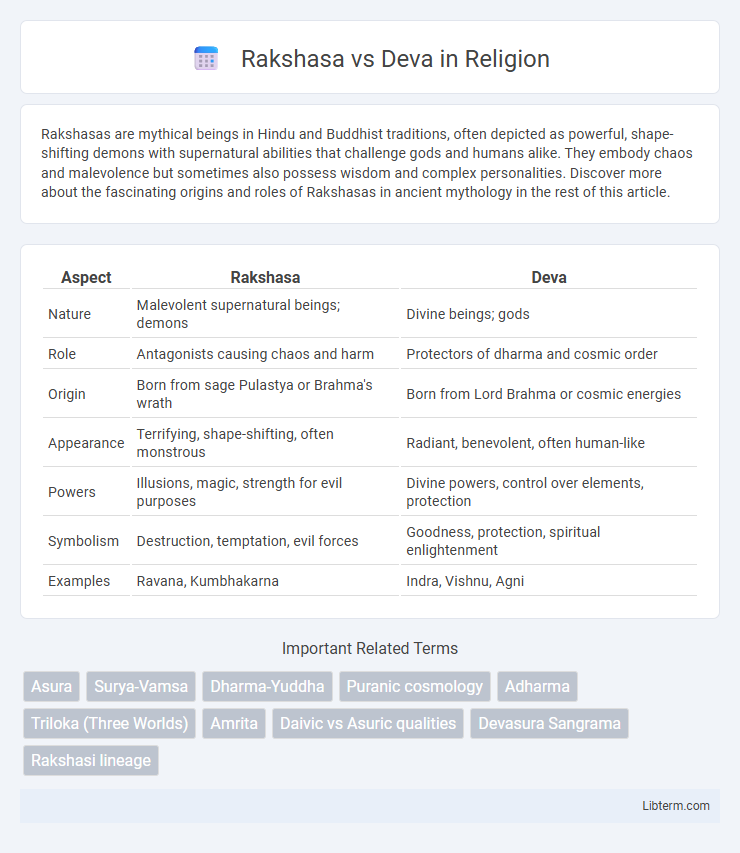Rakshasas are mythical beings in Hindu and Buddhist traditions, often depicted as powerful, shape-shifting demons with supernatural abilities that challenge gods and humans alike. They embody chaos and malevolence but sometimes also possess wisdom and complex personalities. Discover more about the fascinating origins and roles of Rakshasas in ancient mythology in the rest of this article.
Table of Comparison
| Aspect | Rakshasa | Deva |
|---|---|---|
| Nature | Malevolent supernatural beings; demons | Divine beings; gods |
| Role | Antagonists causing chaos and harm | Protectors of dharma and cosmic order |
| Origin | Born from sage Pulastya or Brahma's wrath | Born from Lord Brahma or cosmic energies |
| Appearance | Terrifying, shape-shifting, often monstrous | Radiant, benevolent, often human-like |
| Powers | Illusions, magic, strength for evil purposes | Divine powers, control over elements, protection |
| Symbolism | Destruction, temptation, evil forces | Goodness, protection, spiritual enlightenment |
| Examples | Ravana, Kumbhakarna | Indra, Vishnu, Agni |
Introduction to Rakshasa and Deva
Rakshasas are mythological beings in Hindu mythology known for their supernatural powers and often malevolent nature, frequently depicted as fierce demons who disrupt cosmic order. Devas, conversely, represent divine entities or gods who embody positive cosmic forces, such as light, order, and righteousness. The contrasting roles of Rakshasas and Devas highlight the fundamental duality between chaos and order in Hindu cosmology.
Origins and Mythological Background
Rakshasas originate from ancient Hindu scriptures as malevolent, shape-shifting demons often depicted as antagonists in epics like the Ramayana and Mahabharata, embodying chaos and darkness. Devas, in contrast, are divine beings or gods representing order, light, and cosmic principles, born from the cosmic churning of the ocean (Samudra Manthan) and frequently involved in maintaining universal balance. Their mythological background establishes Rakshasas as forces of destruction opposed by Devas, who uphold dharma and righteousness within the celestial hierarchy.
Physical Appearance and Symbolism
Rakshasas are often depicted with fierce, monstrous features such as sharp claws, fiery eyes, fangs, and dark, menacing skin symbolizing chaos, destruction, and evil. Devas contrast with radiant, divine forms characterized by glowing halos, serene expressions, and regal attire that embody purity, light, and cosmic order. Their contrasting appearances visually represent the eternal struggle between darkness and light, evil and righteousness in Hindu mythology.
Powers and Abilities Compared
Rakshasas possess formidable physical strength, dark magic, shape-shifting abilities, and mastery of illusion, making them formidable supernatural adversaries. Devas demonstrate exceptional divine power, control over natural elements, heightened spiritual awareness, and abilities like flight, healing, and cosmic energy manipulation. The power comparison highlights Rakshasas' destructive and deceptive skills, while Devas exhibit superior divine energy, protection, and cosmic balance capabilities.
Role in Hindu Epics and Scriptures
Rakshasas and Devas play contrasting roles in Hindu epics and scriptures, representing forces of chaos and order respectively. Rakshasas are often depicted as antagonistic demons engaged in battles against the Devas, who embody divine power and righteousness in texts like the Ramayana and Mahabharata. Their conflict symbolizes the eternal struggle between good and evil, with Devas safeguarding cosmic balance and Rakshasas threatening dharma.
Moral Alignment: Good vs Evil
Rakshasas in Hindu mythology are often depicted as malevolent beings embodying evil, chaos, and destructive tendencies, directly opposing the Devas who represent order, righteousness, and benevolence. The moral alignment starkly contrasts as Devas embody divine virtues and protection of dharma, while Rakshasas frequently engage in deceit, violence, and disruption of cosmic balance. This duality underscores the cosmic struggle between good and evil, with Devas upholding cosmic harmony and Rakshasas challenging moral and spiritual order.
Famous Rakshasa and Deva Figures
Famous Rakshasas include Ravana, the ten-headed demon king of Lanka known for his immense power and intellect, and his brother Kumbhakarna, noted for his gigantic size and formidable strength. Prominent Devas feature Indra, the king of gods and god of thunder and rain, renowned for his role in Vedic mythology as a protector of cosmic order, and Agni, the fire god, essential in Vedic rituals for his function as a divine mediator. These figures symbolize the eternal struggle between chaos embodied by Rakshasas and order represented by Devas in Hindu mythology.
Cultural Impact and Representations
Rakshasas and Devas hold profound cultural significance in Hindu mythology, symbolizing the eternal struggle between chaos and order. Devas represent divine forces of light, righteousness, and protection, frequently depicted in ancient scriptures and temple carvings as benevolent celestial beings. Rakshasas, often portrayed as fierce demons embodying darkness and destruction, serve as crucial antagonists in epics like the Ramayana, influencing art, dance, and literature by representing moral conflicts and spiritual lessons.
Lessons and Values in Stories
Rakshasa vs Deva stories emphasize the eternal battle between good and evil, highlighting the importance of righteousness, self-discipline, and moral courage in overcoming malevolence. These narratives teach that virtue, wisdom, and devotion to dharma lead to societal harmony and personal growth, while unchecked desires and cruelty result in downfall. The symbolic contrast encourages introspection on the consequences of one's actions and the pursuit of ethical living.
Contemporary Interpretations and Influence
Contemporary interpretations of Rakshasa and Deva often explore their symbolic representations of chaos and order, highlighting their roles in balancing human nature and cosmic principles. Modern literature, film, and art frequently depict Rakshasas as complex antagonists embodying moral ambiguity, while Devas symbolize divine authority and ethical guidance. This dynamic influences cultural narratives by reinforcing themes of good versus evil, spiritual struggles, and the quest for enlightenment in today's society.
Rakshasa Infographic

 libterm.com
libterm.com